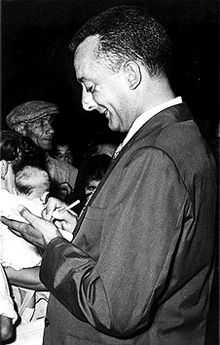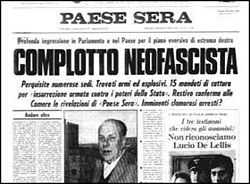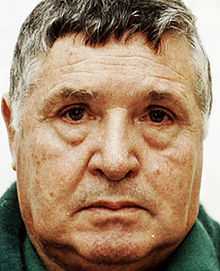Mauro De Mauro
| Mauro De Mauro | |
|---|---|
 | |
| Born |
September 6, 1921 Foggia, Italy |
| Died |
September 16, 1970 Palermo, Italy (body has never been found) |
| Occupation | Journalist |
| Known for | Investigative journalism |
Mauro De Mauro (born September 6, 1921 – disappeared September 16, 1970) was an Italian journalist. He disappeared in September 1970 and his body has not yet been found. His disappearance and probable death remains one of the unsolved mysteries in Italian history.
Several explanations for his disappearance are current. One is related to the death of the president of Italy's state-owned oil and gas conglomerate ENI, Enrico Mattei. Another is that De Mauro had discovered drug trafficking between Sicily and the United States. A third explanation links his disappearance with the Golpe Borghese a planned right-wing coup d'état (the plan failed in December 1970). Apparently De Mauro was convinced that he had got hold of a story of a lifetime. Before his disappearance he told colleagues at the newspaper L'Ora, "I have a scoop that is going to shake Italy."[1][2]
Fascist past
De Mauro was born in 1921 in Foggia, Apulia. His father Oscar De Mauro belonged to a reputable family of doctors and pharmacists that had been living in Foggia for several generations. His mother Clementina Rispoli came from Naples and was a math teacher.[3][4] His younger brother Tullio De Mauro (born March 31, 1932) is a linguist and politician, who became Minister of Education in 2000-2001.
De Mauro was a supporter of the Fascist regime of Benito Mussolini. After the armistice with the Allied Forces in September 1943, he choose to follow the hard-line fascist regime of the Italian Social Republic (Repubblica Sociale Italiana – RSI) in German-held northern Italy. During the German military occupation of Rome in 1943-1944, he was vice-commander of Police under the Commander Caruso, informant of the SS Captain Erich Priebke and of the Colonel Herbert Kappler. He was also a member of the Koch Band, a special unit of the Home Security in the Italian Social Republic.[5][6] Using a variety of aliases (Roberto Marini, Mauro Mauri, Mariani, etc.), De Mauro managed to infiltrate several resistance organizations (in Rome and Milan) to hunt the partisans.[5]
He and his wife Elda volunteered to join the Decima MAS, a brutal anti-partisan force under the command of prince Junio Valerio Borghese, also known as the "Black Prince". De Mauro was arrested during the liberation in Milan in April 1945. He escaped from the prison camp Coltano (Tuscany) in December 1945 and took refuge in Naples with his young wife (where he also had two daughters, Junia and Franca Valeria, named after Junio Valerio Borghese)[7] Accused of having participated in the Fosse Ardeatine massacre,[3][8] he was absolved by the court in 1948.[7]
In Sicily

In 1948, De Mauro moved to Palermo in Sicily under an assumed name, and worked for local newspapers such as Il Tempo di Sicilia, and Il Mattino di Sicilia. In 1959 he started working for L'Ora, a Communist-oriented paper. Other journalists were puzzled about De Mauro's presence at the newspaper: he had been a supporter of Mussolini until the bitter end and fought in the brutal war against the anti-Fascist partisans. Rumour had it that his nose had been broken by partisans.[1]
At L'Ora, De Mauro could exercise his skills as a successful investigative reporter, in particular on issues related to the Sicilian Mafia. He wrote on drug trafficking and the Sack of Palermo, the construction boom in the 1950s and 1960s that led to the destruction of the city's green belt and ancient villas. He also published articles about the collusion between the Mafia and politics. In 1962, he was the first to publish a detailed map of the Sicilian Mafia, which was confirmed 22 years later by the Mafia pentito (turncoat) Tommaso Buscetta in his testimony to Judge Giovanni Falcone.[3]
In January 1962 he published a series of articles in L'Ora disclosing the testimony of Melchiorre Allegra, a medical doctor and a member of the Mafia from 1916 until his arrest in 1937. Upon being arrested, Allegra disclosed his membership and testified about Mafia activities. It was one of the first testimonies about the Mafia from within.[9] In 1960 he was among the winners of the Premiolino, one of the most important Italian journalism awards, for his crime investigations.[10]
Mattei affair

In 1962 he investigated the mysterious death of Enrico Mattei, the powerful president of Italy's state-owned oil and gas conglomerate ENI who died in suspicious circumstances in a plane crash on October 27, 1962. During his controversial tenure of ENI, Mattei had made many enemies. He tried to break the oligopoly of the 'Seven Sisters' (a term Mattei coined to refer to the dominant oil companies of the mid-20th century[11]), and brokered an oil import deal with the Soviet Union in the middle of the Cold War over intense protests from NATO and the U.S. in 1959, while supporting independence movements against colonial powers such as Algeria.[12]
The US National Security Council described Mattei as an irritation and an obstacle in a classified report from 1958. The French could not forgive him for doing business with the pro-independence movement in Algeria. Responsibility for his death has been attributed to the CIA, to the French extreme-nationalist group, the OAS, and to the Sicilian Mafia.[13]
In September 1970, De Mauro was again investigating the case, upon request of the movie director Francesco Rosi for the movie Il caso Mattei (The Mattei Affair), which would be released in 1972.[14] He was convinced that Mattei's aircraft had been sabotaged and looked into possible links of the Mafia with the crash. Two days before his disappearance, De Mauro interviewed Graziano Verzotto, a Christian Democrat politician and former right-hand man of Mattei on Sicily.[15] Verzotto had been head of public relations of ENI[16] and knew De Mauro quite well. Verzotto also knew Mafia boss Giuseppe Di Cristina quite well; he had been best man at De Cristina’s wedding.[17] Verzotto had been with Mattei on his airplane the day before it crashed.[15] De Mauro was convinced that he had got hold of a story of a lifetime. Before his disappearance he told colleagues at the newspaper L'Ora, “I have a scoop that is going to shake Italy.”[1][2]
Disappearance

De Mauro was kidnapped on the evening of September 16, 1970, while coming back home from work, in the via delle Magnolie in Palermo. Thousands of police and Carabinieri with helicopters and dogs combed Sicily in vain in search of the reporter.[18] De Mauro’s body has never been found, a victim of the so-called lupara bianca,[19] despite intensive search efforts by Palermo police assisted by top-level forces from Rome and even a special investigative committee of the Italian Parliament.[20]
The investigations into the disappearance of De Mauro were seriously hampered due to deviations by people within the Italian police forces and secret services. According to police inspector Boris Giuliano, who was involved in the investigation, there was "someone at the ministry in Rome that does not want to go to the bottom of the death of De Mauro."[2] According to Giuliano an order to scale down the investigation was issued by the head of the secret service, Vito Miceli, allegedly involved in the Borghese coup.[21] Miceli had been in contact with the mafiosi Giuseppe Calderone and Giuseppe Di Cristina who wanted to support the coup, scheduled for December 1970.[22]
Italian mystery
The disappearance of De Mauro remained a mystery and a matter for many speculations. In May 1994 Mafia turncoat Tommaso Buscetta declared that the Sicilian Mafia had been involved in the murder of Mattei. He also claimed that De Mauro was killed because of his investigations into the death of Mattei.[23] According to Buscetta, Mattei was killed at the request of the American Cosa Nostra because his oil policies had damaged important American interests in the Middle East.[24] The American Mafia in turn was possibly doing a favour to the large oil companies.[19]
Buscetta claimed that the killing was organized by Mafia bosses Salvatore Greco "Ciaschiteddu", Stefano Bontade and Giuseppe Di Cristina on the request of Angelo Bruno, a Sicilian born Mafia boss from Philadelphia.[24] Gaetano Iannì, another pentito, declared that a special agreement had been achieved between Cosa Nostra and "some foreigners" for the elimination of Mattei which was organized by Giuseppe Di Cristina.[25] These statements triggered new inquiries, including the exhumation of Mattei's corpse.[13]
Buscetta claimed that Mafia boss Stefano Bontade organized De Mauro’s kidnap, because his investigations into the death of Mattei came very close to the Mafia, and Bontade’s own role in the affair.[24] Another pentito, Francesco Di Carlo, declared in 2001 that De Mauro was killed because he had learned that one of his former fascist friends, Prince Junio Valerio Borghese, was planning a coup d'état (the so-called Golpe Borghese) with like-minded army officers determined to stop what they considered as Italy's drift to the left.[1][2][26] Yet another pentito, Rosario Naimo, who started to collaborate with the Italian authorities after his arrest in October 2010, said that the journalist was killed because of his investigative reporting that damaged the Mafia.[27]
The order for the killing of De Mauro came from the heads of the Sicilian Mafia Commission, Stefano Bontade, Gaetano Badalamenti and Salvatore Riina, according to Di Carlo and Buscetta.[2] Both Di Carlo and Naimo say that De Mauro was kidnapped by Emanuele D'Agostino, a mafioso from Bontade’s Santa Maria di Gesù Family.[27]
According to Di Carlo, the remains of De Mauro were buried under a bridge over the Oreto river near Palermo. However, the police, after a search, did not find the body. The pentito Francesco Marino Mannoia later explained why. He had been ordered by Bontade in 1977 or 1978 to dig up several bodies at the bridge and dissolve them in acid.[28] According to the new testimony of the pentito Naimo, De Mauro was taken to a terrain in Pallavicino neighbourhood in Palermo where the Mafia boss Francesco Madonia owned a chicken farm. He was killed there and dumped in a pit.[27]
2006 murder trial

In April 2006 a trial on De Mauro’s murder started at the Court of Palermo with the former Mafia boss of bosses Riina as the only defendant.[29] In 2011 the new Mafia turncoat Naimo testified at the trial saying that the journalist was killed by the Mafia on the orders of Riina.[30] (D'Agostino and Bontate were killed by Riina’s Corleonesi in the Second Mafia War; Badalamenti died in a US prison in April 2004.)
The "awkward journalist" (giornalista scomodo) – as he became known – was kidnapped and killed because the Mafia and their backers wanted to know his sources of confidential and potentially devastating information, according to public prosecutor Antonio Ingroia in his closing speech in March 2011. Perhaps because of information about the disappearance of Eni president Mattei, on which he was working for the film by Francesco Rosi. Perhaps the Borghese coup planned shortly thereafter in which the Mafia appeared alongside nostalgic fascists. Perhaps other events that concerned the "friends in Rome" of the Corleonesi headed by Riina. Perhaps because of a combination of these multiple motives. Cosa Nostra was behind the murder of De Mauro, but there were other backgrounds and individuals, allied with the Mafia, such as deviated freemasons and corrupt public officials. "De Mauro was not killed out of revenge, but to prevent harm to the Mafia. The Mafia did not just execute instructions of others, but also because his investigations affected Cosa Nostra itself and other powers associated with it," according to Ingroia.[31]
Ingroia said the investigations for the trial had unearthed an institutional cover-up in the initial probe into De Mauro's disappearance.[32]
Mystery continues
On June 10, 2011, Riina was acquitted of charges for ordering the kidnap and killing of De Mauro by the Court in Palermo because of insufficient evidence. "It's certainly a surprise, but we'll see the reasons for this ruling," said Franca De Mauro, daughter of the journalist. "I am very upset because after 40 years we still have no answer about what happened that day."[21][33]
In their explanation of the ruling that became public in August 2012, the judges of the Court of Palermo decided that De Mauro had died because he had gone too far in his quest for the truth about the last hours of Mattei in Sicily. They pointed to Graziano Verzotto as a possible man behind the killing of De Mauro and Mattei, but without a clear conviction. Verzotto had died in June 2010.[34][35]
De Mauro’s disappearance and likely death remains one of the unsolved mysteries in Italian history. The Sicilian writer Leonardo Sciascia once summarized the puzzle of De Mauro’s death: "He said the right thing to the wrong man and the wrong thing to the right man."[3]
See also
References
- ↑ 1.0 1.1 1.2 1.3 Revealed: how story of Mafia plot to launch coup cost reporter his life, The Independent on Sunday, June 19, 2005
- ↑ 2.0 2.1 2.2 2.3 2.4 (Italian) De Mauro ucciso per uno scoop: scoprì il patto tra boss e golpisti, La Repubblica, June 18, 2005
- ↑ 3.0 3.1 3.2 3.3 (Italian) De Mauro, l'ultima pista, La Repubblica, February 19, 2009
- ↑ (Italian) Curriculum vitae Tullio De Mauro (accessed January 29, 2011)
- ↑ 5.0 5.1 (Italian) Documenti statunitensi e italiani sulla Banda Giuliano, la Decima Mas e il Neofascismo in Sicilia, by Giuseppe Casarrubea, November 2005
- ↑ (Italian) A 40 anni dalla scomparsa del giornalista De Mauro, eliminato dalla mafia mentre indagava sulle trame nere d’Italia, Arcoiris TV, September 16, 2010
- ↑ 7.0 7.1 (Italian) Mauro De Mauro, by Antonella Romano, in: Giornata della Memoria dei giornalisti uccisi da mafie e terrorismo, Rome: Unione Nazionale Cronisti Italiani, 2008, pp. 28-35
- ↑ (Italian) Mauro De Mauro al tempo della Rsi, blog by Giuseppe Casarrubea, July 7, 2010
- ↑ Testimony of Melchiorre Allegra, ExLEGI website
- ↑ (Italian) Premiolino website
- ↑ The new Seven Sisters: oil and gas giants dwarf western rivals, Financial Times, March 11, 2007
- ↑ Algerian Gas to Europe: The Transmed Pipeline and Early Spanish Gas Import Projects, by Mark H. Hayes, May 2004, prepared for the Geopolitics of Natural Gas Study, a joint project of the Program on Energy and Sustainable Development at Stanford University and the James A. Baker III Institute for Public Policy of Rice University.
- ↑ 13.0 13.1 Autopsy may solve deadly mystery of the Mattei Affair, The Independent, August 29, 1997
- ↑ Carlo Lucarelli, novelist, makes use of Italy's unsolved crimes, The New York Times, October 23, 2007
- ↑ 15.0 15.1 (Italian) Uno spiraglio di luce sui misteri d'Italia, Corriere della Sera, May 14, 2008
- ↑ Servadio, Mafioso, pp. 147-48
- ↑ Servadio, Mafioso, pp. 165-66
- ↑ Investigator of the Mafia Is Kidnapped on Sicily, The New York Times, September 22, 1970
- ↑ 19.0 19.1 Woodhull & Snyder, Journalists in peril, p. 101
- ↑ Vain Search Angers Italian Crime Board, The New York Times, October 14, 1970
- ↑ 21.0 21.1 (Italian) Omicidio De Mauro, assolto Totò Riina, La Repubblica, June 10, 2011
- ↑ (Italian) La verità del pentito su De Mauro, La Repubblica (Palermo edition), June 12, 2011
- ↑ (Italian) Quando Buscetta riapri' il caso, La Repubblica, June 22, 1995
- ↑ 24.0 24.1 24.2 (Italian) Buscetta: 'Cosa nostra uccise Enrico Mattei', La Repubblica, May 23, 1994
- ↑ (Italian) 'Fu Di Cristina a sabotare l'aereo di Enrico Mattei', La Repubblica, June 21, 1994
- ↑ (Italian) "De Mauro venne ucciso perché sapeva del golpe", La Repubblica, January 26, 2001
- ↑ 27.0 27.1 27.2 (Italian) Il debutto in aula dell'ex padrino, La Repubblica, February 19, 2011
- ↑ (Italian) De Mauro, la verità di Mannoia; Sciolsi il suo corpo nell' acido', La Repubblica, October 12, 2006
- ↑ (Italian) Anniversario omicidio Mauro De Mauro, Antimafia Duemila, September 16, 2009
- ↑ (Italian) Mauro De Mauro, “Ecco dov’è il suo corpo”, Le Repubblica, January 14, 2011
- ↑ (Italian) Riina è ancora il capo della mafia, Corriere della Sera, March 5, 2011
- ↑ Mafia 'beast' life term asked in murder of Mattei journalist, Ansa, April 22, 2011
- ↑ (Italian) Riina assolto per l'omicidio De Mauro, Corriere della Sera, June 10, 2011
- ↑ Verzotto, i misteri dell'ex dc nei delitti De Mauro e Mattei, Corriere della Sera, August 9, 2012
- ↑ (Italian) "Delitto De Mauro, Verzotto mandante", Corriere del Veneto, August 9, 2012
- Servadio, Gaia (1976). Mafioso. A history of the Mafia from its origins to the present day, London: Secker & Warburg ISBN 0-436-44700-2
- Woodhull, Nancy J. & Robert W. Snyder (eds.) (1998), Journalists in peril, New Brunswick (NJ): Transaction Publishers, ISBN 0-7658-0441-7
External links
- (Italian) Caso De Mauro, un mistero lungo trentasei anni, Ordine dei Giornalisti di Sicilia, February 15, 2006
- (Italian) Mauro De Mauro, Ordine dei Giornalisti della Lombardia
|
| ||||||||||||||||||||||||||||||||